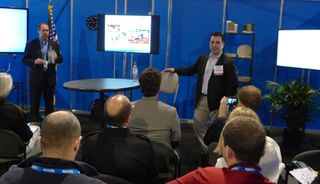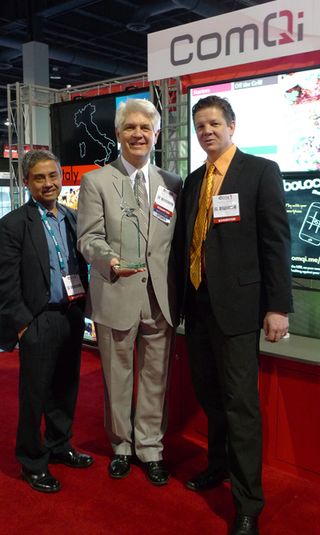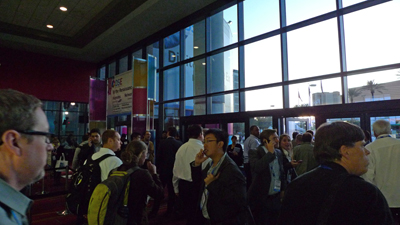After a full day of conferences Tuesday including a great Digital Place-Based Advertising Summit put on by DPAA, and where the focus was more on applications and business/marketing issues, the Digital Signage Expo show floor opened Wednesday with a healthy amount of new product buzz. Even in a general climate where double-digit market growth is in some ways fueled by the commoditization of products (lower end-user prices mean a constantly expanding market) there are at DSE some impressive salvos by the big industry players with new product announcements and partner agreements.
Digital Signage Expo opened Wednesday at the Las Vegas Convention Center to a robust crowd, and all the major gear and software suppliers were on hand to show their wares.
With the caveat that this is no more than a quick look at but a few of the many offerings at DSE, here are some snapshots from the show floor Wednesday.
The two biggest product categories within digital signage are of course flat panel displays, and content management software. Occasionally, someone attempts to make that just one category. The packaging of a simpler content management software offering with a flat panel by the big flat panel makers has not always been successful in terms of new solutions. There are several reasons the market is cautious about such marriages. But I suppose it would not be DSE if at least one major flat panel manufacturer did not announce a bundled flat panel/content management software package. Samsung debuted at DSE yesterday (for the U.S.– there was a soft launch of this at ISE in Amsterdam last month) the Samsung Smart Signage Platform, a new “open-source digital signage platform”. It's not actually a "bundled package" as some previous offerings along these lines have been. Samsung says the Smart Signage Platform is “designed to simplify the digital signage deployment process while facilitating the growth of a new application ecosystem with leading software developers and content providers.” Available on select Samsung large-format displays launching later this year, the Smart Signage Platform is an integrated, open-source platform built around an embedded media player and software developer kit (SDK). What does that mean? Samsung is offering a software developer kit (SDK)– see: www.samsungforum.com–built around an imbedded Linux platform, whereby other digital signage content management software publishers can write new (simpler) versions of their offerings to run on the Samsung hardware/software platform. (The end user sees no increase in the price of the panel.) Essentially, from a hardware perspective, Samsung is providing the end user an imbedded media player. Third party content management software providers will get some new customers they might not have otherwise found, most of which need a simpler solution that those software providers would typically provide.
At a Samsung demo at DSE Wednesday, Raffi Vartian, COO at signagelive, explained how his company is making a version of its software available in this endeavor.
- “The PC is what trips up a lot of digital signage deployments," said Vartian. “If you look at a lot of verticals– like digital menu boards– the benefit of having the media player built into the screen is enormous, for cost of ownership issues… We think this new platform with help take digital signage and get it out to the masses.”
Planar is showing at DSE their stunning new 84-inch Planar UltraRes display product line, for ultra-high resolution commercial applications, with a resolution of 3840 x 2160.
Samsung’s Kevin Schroll, senior product marketing manager for large format displays, said that companies like Four Winds and Capital Networks have taken interest in this new platform. Samsung is seeking more participants from the digital signage content management software community.
Jonathan White, CTO of Capital Networks, told me that “we were able to adopt our web-based software for the Samsung platform. We looked at their SDK. We did some proof of concept, and it worked.”
Echoing comments from other participants and analysts, White said that their hope is that they gain more customers from a different part of the market, for which the new Samsung imbedded media player is fine. The new Samsung platform is not designed for industrial-strength digital signage. It won’t do complex multi-zone well. It won’t accommodate touch/interactive digital signage. But the platform, essentially an HTML5 web browser, should handle most video well, at 1080P, and is sufficient for a lot of applications.
To get content up on screens, you need either a PC, or an “appliance” type of media player. That new Samsung announcement addresses what is really becoming a hotbed of competition and controversy, over the best way to do that.

Samsung debuted at DSE yesterday the Samsung Smart Signage Platform, a new “open-source digital signage platform”. Samsung’s Kevin Schroll (on left), senior product marketing manager for large format displays, and Raffi Vartian, COO at signagelive explained the new hardware/content management software bundling initiative.
This year, there is more obvious division into distinct camps– mainly the Windows camp, and the appliance camp. And now, a subset of the appliance camp– Android-based media players. Audience for Android is the new (DIGI-Award winning) offering from Capital Networks. Broadsign in bringing to market a new $99 Android-based media player. ViewSonic uses an embedded Android player in some screens. There are others coming. It might at first glance seem odd that Samsung’s new imbedded media player for the Smart Signage offering is not Android, given Samsungs strength in that area in the smartphone arena– but certainly the low hanging fruit in terms of expanding the market quickly for simple digital signage is in the straight HTML5 arena. While Android is going to come on strong due the fact that writing to Android will mean compatibility to the new tablet platforms, and because Android has built-in 3G and geo-tracking features, today there are not enough digital signage programmers that have made the switch. And there are still many who think–correctly– that high end, multi-zone digital signage needs a PC to run content
Will the explosion of Android tablets eventually lead to new crops of Android-based content management for our space? It's happening now, because the same kinds of relentless economies of scale whereby LCD flat panels– manufactured in such huge volumes and used in so many industries– were able to drive display costs down and so roll over market share, are at work with Android, thanks to the tablet and smartphone juggernauts.
AOpen was showing its new Android-based OpenSign at DSE, a small-screen “personal shopper” with signage at the booth saying “Operates on Android – Cheaper on Android”.
Philips also was advertising “Android Signage Solutions” at its booth at DSE.
I caught up with John Wang, CEO of IAdea, at the Scala booth (IAdea was showing its Digital Signboard in the Scala booth at DSE), and Wang said that they are going all-Android from now on with their media players. “There is of course a huge momentum for Android coming from the consumer market, but Android comes with a lot of challenges.” Wang mentioned reliability issues, and the fact that Android code has not historically been “locked down” i.e. it’s not immune to hacking– not a big concern in a digital signage installation at your locals doctor’s office but a big one in a corporate rollout involving hundreds or even dozens of screens. Wang stressed the fact that IAdea does not even include the word Android in its product lieterature– because Wang says that they “heavily modify the Android source code to make it more robust, and more secure.” Wang said that just using Android straight out of the box, could be a roll of the dice.
On the display side at DSE, well, who could not love the new 4K resolution LCD panels on display from a couple of major players? Planar is showing their stunning new 84-inch Planar UltraRes display product line, for ultra-high resolution commercial applications, with a resolution of 3840 x 2160. It features edge-lit LED technology and passive cooling. The LED light source of course means no lead or Mercury, and they are fanless and quiet.

(from left to right) Comqi’s CEO Ajay Chowdhury; president, Americas, Stuart Armstrong; and chief technology officer Max Stevens-Guille show off their 2013 DIGI Award for Best New Content Management Software/Web-based, that they snagged for their Passport, at their booth at DSE.
LG also showed 4K LCD panels at their booth. And LG’s IPS technology is impressive for its deep deep blacks and high contrast ratio.
Samsung is supposedly coming out with 4K in the fall. Sharp is now distributing a 4K 32 inch panel.
At DSE, Viewsonic was showing its 84 inch 4K interactive screen.
Of course– getting back to the industry scrimmages in the “media player” arena– there are, today, no media players that can play 4K. You need a PC to output 4K at true, native resolution. Long live high res, in this industry. PC or no PC– who wants the inexorable drive toward higher res, more beautiful images to falter. God forbid that this– or any branch of the video industry– should go over the resolution cliff that audio careened over years ago, with disastrous results. At the end of a long day on the show floor at DSE, it’s still just wonderful to see those lush, deep images on those high res screens– a sight for sore eyes, and a testament to the fact that we’re still on a roll in this media, the newest kid on the new media block.










